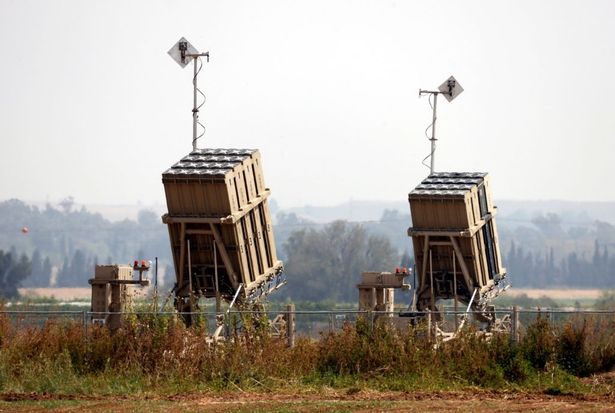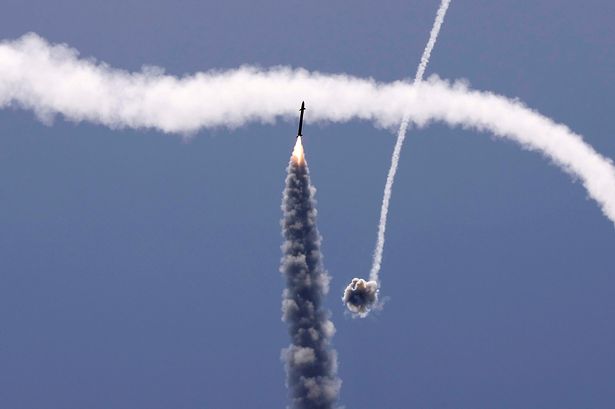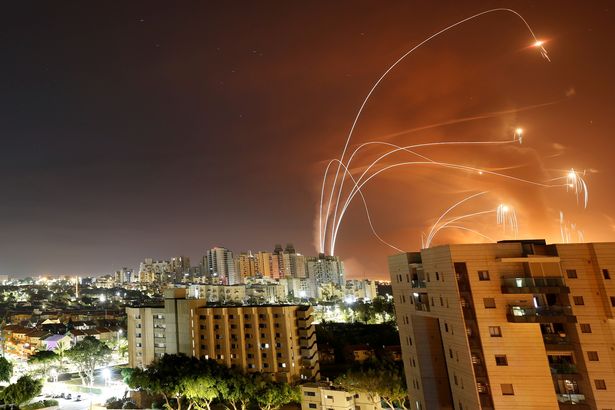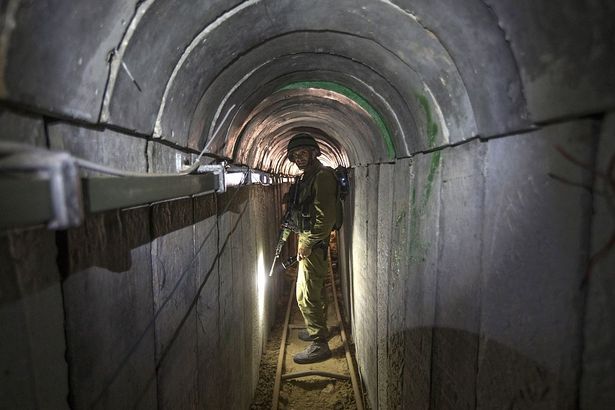With tensions between Israel and Hamas rising by the hour, their deadly arsenals threaten to make it the bloodiest conflict yet.
A fresh outbreak of attacks has left at least 74 people dead – including 67 Palestinians and six Israelis, many of whom are children.
Israel is now said to be making plans for a ground assault in the volatile Gaza territory, readings troops and tanks at the border.
In the face of more than 1,000 rocket attacks from Hamas, the UN has warned the region is heading for “all out war”, prompting world leaders including US President Joe Biden to call for immediate de-escalation.
Since the region’s last major war in 2014, Hamas has amassed a huge array of ballistics that are putting Israel’s military under mounting pressure.
But with deadly ‘kamikaze drones’, high-tech fighter jets and multi-billion pound defence systems at his disposal, Prime Minister Benjamin Netanyahu has no shortage of options to counter the Islamist faction.

(Image: AFP via Getty Images)
Hamas’ ‘cottage industry’ of missiles
Hamas has relied heavily on its vast array of air-to-air missiles and mortars, many of which have been produced on site in the Gaza Strip.
Its manufacturing bases have become a key target for Israeli air strikes, though Palestinian groups have also previously smuggled in weapons parts from Iran and Syria.
Hamas’ artillery rockets are basic in design, based on Soviet-era technology, but the group is now believed to hold huge stockpiles, ranging from 20,000 to 30,000 in number.

(Image: AFP via Getty Images)
“They have quite a nice cottage industry and they produce rockets based on blueprints and advice that they have gotten from Iran and others,” Israel Defence Forces (IDF) official Jonathan Conricus has said, adding that the arsenal is “on a par with the fire capability of small European countries”.
Of particular concern to Israel is the increased production of longer range systems, which according to the BBC include the Fajr (up to 100km), the R-160 (up to 120km), and M-302 (up to 200km).
While many of the short-range missiles will fall as short as the Gaza Strip itself, the advanced weaponry could in theory target major cities like Jerusalem and Tel-Aviv, posing a huge threat to civilian populations.
‘Kamikaze drones’ and anti-UAV rifles
Israel boasts a highly advanced fleet of drone technology, used both for military operations and surveillance.
Last year, the IDF bought up the Hero-30 system – in effect a ‘kamikaze drone’ – and successfully used it in combat, according to manufacturer UVision.
The lightweight drone is known as a “loitering munition”, because it explodes when hitting a target rather than returning to base.

(Image: AFP via Getty Images)
Israel has also purchased anti-drone technology, including a tracking system that can be attached to rifles which allows users to track and fire at enemy Unmanned Aerial Vehicles (UAVs) with precision.
The technology is produced by Israeli company Sharp Shooter, which says it is also being used by the US military.
While Hamas’ technology is significantly less advanced, the IDF on Wednesday said it had shot down a drone attempting to cross into Israel from the Gaza Strip.
Footage was released on Twitter of the moment an ‘explosive UAE’ was shot down by armed forces.
Radar-busting fighter jets
In efforts to destroy Hamas’ extensive hoard of rockets, Israel is able to call upon a squadron of world-leading fighter jets.
The nation has established close military ties with the US, which has supplied cutting-edge aircraft including the F-35 Lightning-II.
The plane allows pilots 360 degree views of targets, while boasting advanced radar avoidance systems that grant it near invisibility.

(Image: Ministry of Defence via Getty Images)
“The plane’s shape is designed to deflect radar energy away from the source like a slanted mirror,” Paul Poitras, a director at manufacturer Lockheed Martin, told the Washington Post.
“Its surface is also blended and smoothed to enable radar energy to smoothly flow across it – similar to water flowing across a smooth surface.”
On Monday, the IDF said it had deployed 80 fighter jets, including the F-35, in an operation to neutralise Hamas’ missiles.
The military said it was targeting dozens of rocket launch tubes buried in the northern Gaza Strip.
Multi-billion pound ‘Iron Dome’
Israel’s chief defence system is the multi-billion pound Iron Dome, a mobile air defence system that disrupts enemy missiles entering the country.
First deployed in 2011, the Dome typically intercepts between 85 per cent and 95 per cent of rockets, with the IDF claiming it is currently operating at a 90 per cent success rate.

(Image: REUTERS)
However, the latest round of attacks has proved the system’s toughest test yet.
In the last major Gaza war in 2014, the daily rocket count fired at the Dome hit around 200 at its peak.
Over recent days, Hamas has significantly upped scale, at times firing up to a hundred in a matter of minutes.
If Hamas continues to fire at such a rate, it will only further strains on the Dome, which relies on powerful, costly batteries.
A malfunction in the battery system was reportedly behind a temporary failure to deflect missiles this week, leading to the deaths of two Israeli women in their homes in Ashkelon.
‘Skunk water’ crowd-control weapon
On the streets of Jerusalem, tensions have boiled over in recent days as Israeli forces clash with Palestinian protesters.
Authorities are said to have left hundreds injured after responding with a bombardment of rubber bullets, tear gas and shock grenades.
Perhaps the most notorious anti-crowd measure being deployed, though, is ‘skunk water’, a non-lethal weapon that clings to hair, skin and clothes.

(Image: REUTERS)
First used by the Israeli military against demonstrators in 2008, the foul spray is said to smell like a “mixture of excrement, noxious gas and a decomposing donkey”.
While its creators insist the liquid is non-toxic, its chemicals have been known to cause violent vomiting, skin and eye irritation, abdominal pain and breathing difficulties.
Underground wall to block ‘terror tunnels’
Since the construction of the Israel-Gaza border barrier, Hamas has relied on a labyrinth of underground tunnels to launch ground attacks.
During the 2014 war, former Hamas prime minister Ismail Haniya hailed the network as “a new strategy in confronting the occupation and in the conflict with the enemy from underground and from above the ground”.

(Image: AFP via Getty Images)
Their construction has since resulted in a cat and mouse race to both build and destroy the tunnels, with Israeli flooding dozens over the last decade.
In addition to militant operations, the network has also played a vital role in smuggling weapons and civilian goods such as food and clothes, with Gaza facing blockades by Israel and Egypt.

Video Unavailable
In recent years, however, Israel has sought to protect itself from surprise attacks via the ‘terror tunnels’ through the construction of an underground wall spanning the 40km width of the border.
Completed in March, the project – hailed as a “game changer” by the IDF – is estimated to have cost nearly £600million and poses an existential threat to Hamas’ options beyond air attacks.


